The Identification and Light Sensitivity of Japanese Woodblock Print ...
The Identification and Light Sensitivity of Japanese Woodblock Print ...
The Identification and Light Sensitivity of Japanese Woodblock Print ...
Create successful ePaper yourself
Turn your PDF publications into a flip-book with our unique Google optimized e-Paper software.
Connors, Page 8 <strong>of</strong> 9<br />
light-sensitivity testing should be considered an evaluation <strong>of</strong> a dark color’s current<br />
stability <strong>and</strong> should not be extrapolated to light exposure doses greater than those used in<br />
the test.<br />
It was also shown that the prior fading history <strong>of</strong> a print does not seem to affect<br />
the light sensitivity <strong>of</strong> safflower red. This suggests that safflower red (or the natural<br />
organic materials that make up safflower red) is not a mixture <strong>of</strong> materials with different<br />
light sensitivities. Instead, the color is produced by a single colorant or colorants with<br />
very similar light sensitivities. <strong>The</strong>refore, faded areas <strong>of</strong> color will not achieve greater<br />
light stability from loss <strong>of</strong> a light sensitive component.<br />
<strong>The</strong> tests performed during this study do give a good prediction <strong>of</strong> a color’s light<br />
sensitivity; however, they do not indicate how much color change has already occurred.<br />
Curators, conservators, <strong>and</strong> scholars should be cautious in their assessment <strong>of</strong> color on<br />
traditional <strong>Japanese</strong> prints. Many colors become paler as they fade, but some printers<br />
intentionally dilute colors, so pale prints are not necessarily faded, although this is <strong>of</strong>ten<br />
the case.<br />
Acknowledgements<br />
Experimental work was performed at the Carnegie Museum <strong>of</strong> Art <strong>and</strong> the<br />
Library <strong>of</strong> Congress <strong>and</strong> was supported by grants from the Andrew W. Mellon<br />
Foundation <strong>and</strong> the United States Japan Foundation. <strong>The</strong> authors would like to thank<br />
Shiho Sasaki for many informative discussions regarding <strong>Japanese</strong> colorants <strong>and</strong> for<br />
preparation <strong>of</strong> dayflower blue samples used in laboratory analysis. This work would not<br />
have been possible without the assistance <strong>and</strong> consultation <strong>of</strong> Linda Batis <strong>and</strong> Ellen<br />
Baxter from the Carnegie Museum <strong>of</strong> Art. <strong>The</strong> twenty-three prints from the Library <strong>of</strong><br />
Congress were chosen in consultation with Library staff Linda Stiber Morenus, Senior<br />
Paper Conservator; Katherine Blood, Curator for Fine <strong>Print</strong>s; <strong>and</strong> Betty Fiske, contract<br />
paper conservator specializing in <strong>Japanese</strong> prints. <strong>The</strong> materials selected by this team for<br />
study were representative <strong>of</strong> a historical cross-section <strong>of</strong> the Library’s <strong>Japanese</strong> print<br />
collection, dating from the early eighteenth century through the nineteenth century. <strong>The</strong><br />
authors would also like to Dianne van der Reyden, Maria Nugent, Jeremy Adamson, <strong>and</strong><br />
Harry Katz from the Library <strong>of</strong> Congress for their contribution to this project.<br />
References<br />
American Society for Testing <strong>and</strong> Materials. 1999. ASTM D5067-98, st<strong>and</strong>ard for artists’<br />
oil, resin-oil <strong>and</strong> alkyd paints. In 1999 Annual Book <strong>of</strong> ASTM St<strong>and</strong>ards: Paints, Related<br />
Coatings <strong>and</strong> Aromatics, ed. R. Allen, et al., 442-447. West Conshohocken: American<br />
Society for Testing <strong>and</strong> Materials.<br />
Feller R., M. Curran, <strong>and</strong> C. Bailie. 1984. <strong>Identification</strong> <strong>of</strong> traditional organic colorants<br />
employed in <strong>Japanese</strong> prints <strong>and</strong> determination <strong>of</strong> their rates <strong>of</strong> fading. In <strong>Japanese</strong><br />
<strong>Woodblock</strong> <strong>Print</strong>s: A Catalogue <strong>of</strong> the Mary A. Ainsworth Collection, ed. R. Keyes., 253-<br />
266. Oberlin: Oberlin College.<br />
Keyes, K. 1988. <strong>Japanese</strong> print conservation – an overview. In <strong>The</strong> Conservation <strong>of</strong> Far<br />
Eastern Art, ed. J. Mills, P. Smith, <strong>and</strong> K. Yamasaki, 30-36. London: IIC.



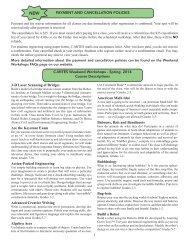

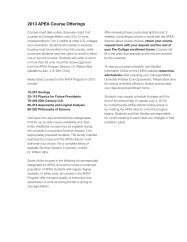

![Pittsburgh Neighborhoods [.pdf] - Carnegie Mellon University](https://img.yumpu.com/22011290/1/190x115/pittsburgh-neighborhoods-pdf-carnegie-mellon-university.jpg?quality=85)
![Curriculum Vitae [.pdf] - Carnegie Mellon University](https://img.yumpu.com/20737100/1/190x245/curriculum-vitae-pdf-carnegie-mellon-university.jpg?quality=85)
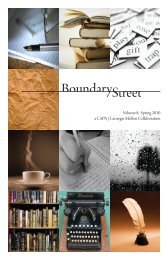
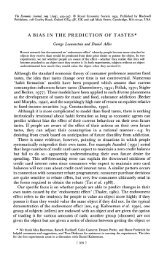


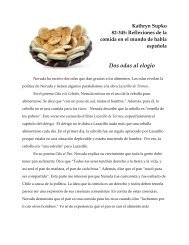


![May 2012 [.pdf] - Carnegie Mellon University](https://img.yumpu.com/12198417/1/190x253/may-2012-pdf-carnegie-mellon-university.jpg?quality=85)
